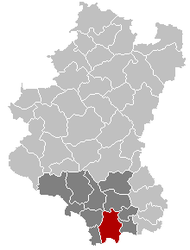Virton
| Virton | |||
|---|---|---|---|
| Municipality | |||

The town hall
|
|||
|
|||
| Location in Belgium | |||
| Coordinates: 49°34.05′N 05°31.95′E / 49.56750°N 5.53250°ECoordinates: 49°34.05′N 05°31.95′E / 49.56750°N 5.53250°E | |||
| Country | Belgium | ||
| Community | French Community | ||
| Region | Wallonia | ||
| Province | Luxembourg | ||
| Arrondissement | Virton | ||
| Government | |||
| • Mayor | François Culot (IC-MR) | ||
| • Governing party/ies | CDH, PS | ||
| Area | |||
| • Total | 94.49 km2 (36.48 sq mi) | ||
| Population (1 January 2016) | |||
| • Total | 11,389 | ||
| • Density | 120/km2 (310/sq mi) | ||
| Postal codes | 6760-6762 | ||
| Area codes | 063 | ||
| Website | (French) virton.be | ||
Virton (French pronunciation: [viʁ.tɔ̃]) is a Walloon municipality (French: commune) located in the Belgian province of Luxembourg. It is also the administrative centre of the district (arrondissement) of the same name, as well as the principal town of the small region of Belgian Lorraine known as the Gaume, famous for its microclimate.
The municipality consists of the following sub-municipalities: Virton proper, Bleid, Ethe, Latour, Ruette, and Saint-Mard. Other population centers include: Chenois, Gomery, Grandcourt, and Saint-Remy.
Several archeological finds indicate that the area was already inhabited before the Romans built villas there and named the town Vertunum. In the early 5th century, the Romans had to flee the Germanic invasions. Their settlement was destroyed and rebuilt by the Franks somewhat north of its original site.
Virton was mentioned for the first time in Pope Lucius III’s bull of 1183 as a fiefdom of the House of Chiny. As overlords of Virton, the Counts of Chiny could levy taxes (the tonlieu) on the various goods sold at the local market, which is attested as early as 1270. In 1441, the Duchy of Luxembourg was sold to Philip the Good, Duke of Burgundy. From that date, Virton, like many other Walloon cities, became embroiled in more than two centuries of wars between France, Spain, and the Netherlands, with all the fighting, famine, epidemics (including plague), and economic disasters that ensued. The city fared better under the rule of Maria Theresa of Austria in the 18th century, thanks in part to the development of Lorraine's steel industry.
...
Wikipedia




